Yoga can benefit aspects of ourselves that are often affected by stress: our mind, body and breathing. The areas of the body that tend to carry the most stress (tense muscles) are the neck, shoulders and back. These seven yoga poses can help loosen and relax these tight muscles.
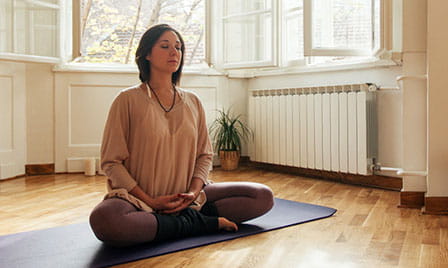
Basic spine flex
Benefits: Stretches and strengthens the lower back. It also promotes a sense of calm.
How to: Sit comfortably on the floor in a cross-legged position. Place your hands on the shins right above the ankles; right hand on the right shin, left hand on the left shin. Inhale through the nose as you lift the chest up high and arch the lower back. As you exhale through the nose, slump back, tilting the pelvis, pushing the lower back out and allowing the chest to collapse. Keep the chin level. There is no need to arch the neck in either direction. Keep the shoulders down and relaxed throughout the exercise.
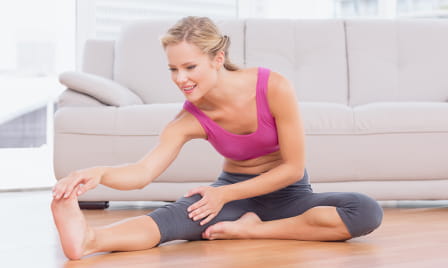
Front stretch left and right
Benefits: Strengthens the life (sciatic) nerve. It is good for the lower back, stretches the hamstrings and relaxes the quads.
How to: Sit comfortably on the floor with the left leg extended straight out in front of you. Rest your right foot against the left inner thigh with the heel as close to the groin as possible. Gently stretch the length of your body over the extended left leg, allowing your hands to rest on the knee, shin or toes. Gently stretch forward, then down towards your toes. Breathe long, slow and deep with eyes closed, or if you prefer with eyes gently opened. Release the pose and sit upright. Shake the legs out a bit, switch legs and repeat.
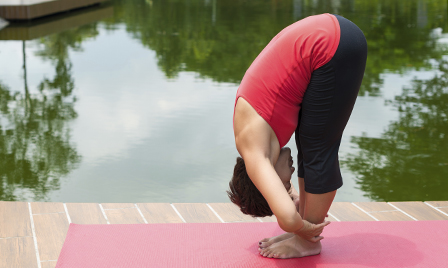
Standing forward bend
Benefits: Great for relaxing the upper back, neck and shoulders. It brings extra circulation to the head.
How to: In a standing position, place feet shoulder-width apart. Allow your body to hang over the waist like a rag doll. Keep the knees slightly bent for comfort. Let the shoulders, neck and head hang totally relaxed. Breathe normally.


Cat/cow pose
Benefits: This is a total spine exercise. It brings extra circulation into the face and head and releases pent-up energy.
How to: Begin on your hands and knees, with your hands flat on the floor directly under your shoulders. Point fingers straight ahead and lock the elbows. Knees are straight down from the hips and are about six inches apart. Tops of feet are resting on the floor. Inhale as you tilt the pelvis forward and arch the back. Left the head up and back (cow position). Exhale as you tilt the pelvis the opposite way and at the same time push up through the shoulders, arching the back like a Halloween cat. Tuck the chin into the chest (cat position). Inhale through the nose into cow position. Exhale through the nose into cat position. Allow the motion to become smooth with your breath.
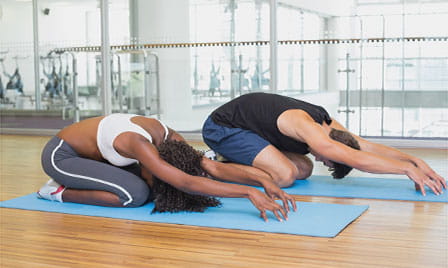
Child’s pose
Benefits: Helps to quiet the mind, easing stress and anxiety, while gently stretching the back.
How to: While sitting on the heels, bring the forehead to the floor and stretch the arms forward, with palms on the floor. Hold the position as you breathe long, slow and deep. An alternative position is to rest the arms alongside the body, hands near the buttocks, palms facing up. This variation is called baby pose.
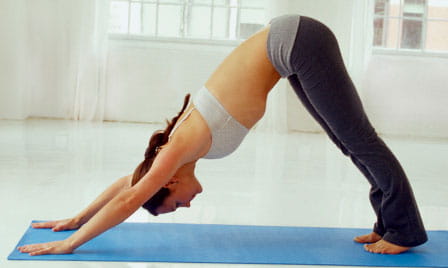
Downward dog
Benefits: This exercise is a good total body stretch used to energize the life (sciatic) nerve and navel point (where thousands of nerve endings meet) to support nervous system strength.
How to: Stand with feet pointed straight ahead and shoulder width apart. Bend from the waist (creating a right angle) and place hands on the floor with thumb tips touching, if possible. Keep elbows and knees straight and your head in line with the upper arms. Tilt the pelvis forward (toward legs) and push down through the shoulders, keeping equal weight on the hands and feet. Hold the position as you breathe long, slow and deep. When you do this exercise, it is good to gently challenge yourself, but not to overdo it. You can also modify this exercise to your special needs by bending the knees for comfort.
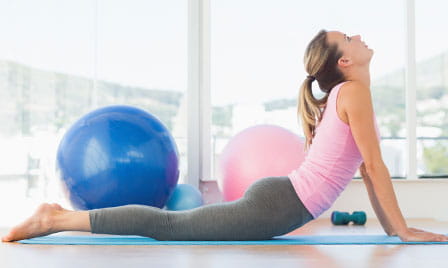
Cobra stretch
Benefits: This exercise opens the diaphragm, heart area and chest. It increases flexibility, rejuvenates spinal nerves and circulates blood throughout the spine and organs while relaxing the lower spine.
How to: Lie down flat on your stomach with chin to the ground. Place hands slightly forward of shoulders, palms down, fingers forward on your mat. Elbows are bent. Keep the legs as close together as possible with the tops of the feet on the ground. Inhale and raise the head and chest up and then push through your arms to lift yourself up. Arms should be shoulder width apart, elbows a little bent, shoulders rolled back and down, chest high and head back. The whole pelvic area is on the ground. You can rest on the forearms if it is more comfortable for you. Breathe long, slow and deep.
Yoga is a Sanskrit word meaning yoke or union – with yoga we are uniting the mind, body and spirit. A regular yoga practice will increase flexibility, strength and balance, as well as facilitate deep relaxation and awareness. The effect is one of feeling more balanced, calm, focused and relaxed as you go through life’s ups and downs.
Best practices for your yoga practice
Here are some things you’ll want to keep in mind during your yoga practice:
- Stay in the moment. Instead of letting your thoughts wander (your to-do list or recapping an argument with your partner) think about what your body and breath are doing. Simply allow yourself to be as you are in the moment. As you do the exercises, try to let go of the idea of “perfect” and how you think it should be. Pay attention to the experience and how the pose affects your body.
- Feel your way. Yoga involves feeling, instead of thinking, your way through a posture/pose. Move slowly and listen to your body. It is good to gently challenge the body while exploring your limits, but never push to the point of pain.
- Listen to your breath. Keep your breath slow, deep and rhythmic. This will help you relax into a yoga pose. If you find your breath becoming short, tense or shallow, focus on breathing in through your nose (for five counts) and out through your mouth (for five counts).
- Avoid judgment. Each of us come from a unique place, with a unique body and unique circumstances. It is important to acknowledge that you are different from your teacher and other people in the room. Avoid judging your body, feelings and thoughts as they arise during your practice.
As with all good things, the effects of yoga may not be instantaneous, they need to build up over time. Give yourself a half hour each day to do a few yoga poses, after a couple of weeks you should start noticing a subtle change in your mood and energy. Stick with yoga and it will become a natural part of your daily routine and help you manage daily stress.














